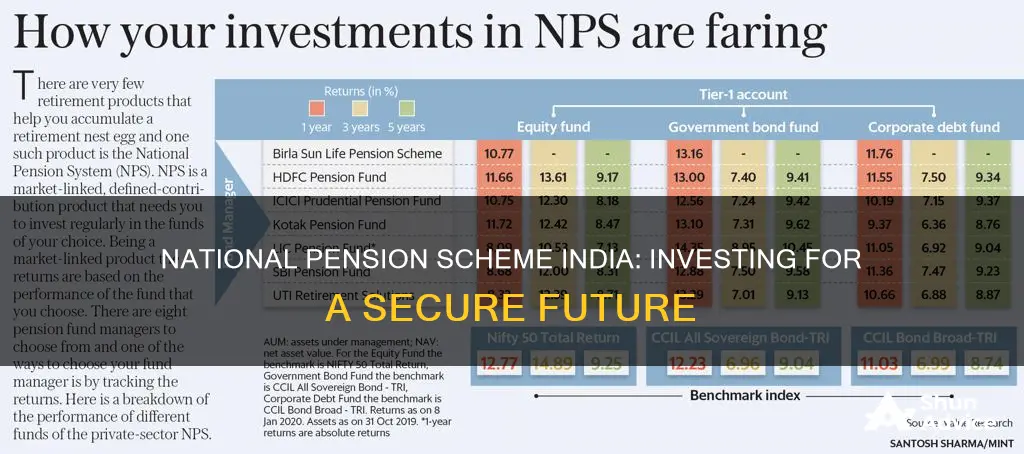
The National Pension Scheme (NPS) is a social security initiative by the Indian government to encourage citizens to invest in a pension account during their working years. The scheme is open to all Indian citizens between the ages of 18 and 60, including NRIs, and offers tax benefits under Section 80C and Section 80CCD(1B) of the Income Tax Act. The NPS has two types of accounts: Tier I, which is the primary pension account with certain withdrawal restrictions, and Tier II, a voluntary savings account that offers flexibility in withdrawals. Individuals can invest in the NPS through online platforms or offline at designated Points of Presence (PoP).
What You'll Learn

How to open an NPS account online
The National Pension Scheme (NPS) is a social security initiative by the Indian Central Government. The scheme is open to employees from the public, private, and unorganised sectors, except those from the armed forces. NPS is a voluntary scheme and is open to all Indian citizens aged between 18 and 60 years.
Visit the eNPS portal:
Visit the eNPS portal of the Central Record Keeping Agency (CRA) of your choice to open an NPS account online. The official website to open an NPS account is https://enps.nsdl.com/eNPS/NationalPensionSystem.html.
Register online:
Register online by linking your account to your mobile number, Aadhaar, and Permanent Account Number (PAN). An OTP will be sent to your registered mobile number to complete the validation.
Receive your PRAN:
Upon completion of registration, you will receive a PRAN (Permanent Retirement Account Number), which can be used to log in to your NPS account.
Make the initial deposit:
Make an initial deposit into your account. The minimum contribution to a Tier I NPS account in a year is INR 1,000, and the minimum one-time contribution is INR 500. You will also need to pay a one-time registration fee.
Activate your account:
You will receive a welcome kit containing your PRAN and password, which can be used to activate and operate your account online.
Log in to your NPS account:
You can log in to your NPS account online through the NSDL NPS portal or your internet banking account.
Choose your investment options:
The NPS scheme offers flexibility, allowing you to choose your investment options and operate your account from anywhere in India.
Additional information:
- The NPS scheme has two types of accounts: Tier I and Tier II. Tier I is the primary account, which is mandatory for all subscribers, while Tier II is an optional additional account.
- NPS offers tax benefits under Section 80C and Section 80CCD of the Indian Income Tax Act.
- The NPS scheme was initially aimed at Central Government employees but has since been extended to all citizens.
- The scheme offers portability, allowing you to use your NPS account across different jobs and locations.
By following these steps, you can easily open an NPS account online and start planning for your retirement.
The Future of Investment Management: Technology's Role
You may want to see also

How to open an NPS account offline
To open an NPS account offline, you can follow these steps: First, locate and visit the nearest Point of Presence (PoP) for NPS services. These PoPs are typically associated with banks or other financial institutions. You will need to submit a physical application form, so ensure you have all the necessary documents with you when you visit the PoP. You can find a list of authorized PoPs on the NPS Trust website or ask your preferred bank if they offer NPS services.
The documents required include proof of identity, proof of address, and recent photographs. The application form, known as the Subscriber Registration Form (SRF), can be obtained from the PoP or downloaded from the NPS Trust website ahead of time. Ensure that you carefully fill out the form and provide accurate information. Along with the SRF, you will also need to submit a duly filled and signed nomination form.
When you visit the PoP, you will be guided through the process of filling out the forms if needed, and you will have to make the minimum contribution to activate your NPS account. The minimum contribution amount may vary, so check the latest guidelines. You will receive a receipt for your initial contribution, and your NPS account will be activated.
After activating your account, you will be provided with a unique Permanent Retirement Account Number (PRAN). This number will serve as your identification for all future transactions and correspondence regarding your NPS account. Keep this number safe, as it is essential for managing your pension fund and making contributions in the future.
While opening an NPS account offline requires a visit to a PoP, it offers personalized guidance and assistance with the process. It is ideal for individuals who may not be comfortable with online procedures or require more hands-on support. Remember to carry all the necessary documents and be prepared to make the minimum contribution to activate your account during your visit to the PoP.
Selling an Investment Management Firm: Strategies for Success
You may want to see also

The two types of NPS accounts
The two primary account types under the National Pension Scheme (NPS) are Tier I and Tier II. The former is the default account, while the latter is a voluntary addition. Here is a detailed explanation of the two account types:
Tier I:
- Tier I is a pension account that is mandatory for everyone who opts for the NPS scheme.
- Central Government employees have to contribute 10% of their basic salary. For everyone else, the NPS is a voluntary investment option.
- The minimum contribution for opening a Tier I account is Rs. 500 per month or Rs. 1,000 per annum.
- Withdrawals from a Tier I account are restricted and subject to terms and conditions.
- Contributions up to Rs. 50,000 made in this account are eligible for additional tax deductions.
- Subscribers cannot withdraw the investments made towards the account until they retire.
Tier II:
- Tier II is a voluntary account that provides liquidity of funds via investments and withdrawals.
- The minimum deposit for a Tier II account is Rs. 250.
- Investments in Tier II accounts are allowed only when an active Tier I account in the subscriber's name exists.
- There is no tax benefit available for Tier II accounts.
- Subscribers will be able to withdraw the contributions made towards the account.
Investing for Retirement at 30: A Guide for Indians
You may want to see also

Tax benefits of investing in NPS
Investing in the National Pension Scheme (NPS) in India comes with a range of tax benefits. Here is a detailed breakdown of these benefits:
NPS Tier I Account Tax Benefits
The Tier I account is mandatory for all NPS investors. Investments in this account are eligible for tax deductions under Section 80CCD (1), Section 80CCD (1B), and Section 80CCD (2) of the Income Tax Act, 1961. Here are the specific tax benefits:
- Self-contribution of up to Rs. 1.5 lakh can be claimed as a tax deduction under Section 80CCD (1).
- Government employees can claim a deduction of 14% of their salary, while private sector employees can claim 10% under Section 80CCD (1).
- Additional deductions of up to Rs. 50,000 can be claimed for self-contribution under Section 80CCD (1B).
- Contributions by the employer to NPS can be claimed by salaried individuals under Section 80CCD (2). The cap is 14% of the salary for government employees and 10% for private sector employees.
NPS Tier II Account Tax Benefits
The Tier II account is voluntary, and there are no restrictions on withdrawals. However, there are currently no tax benefits associated with this account type.
Other Tax Benefits under NPS
In addition to the annual tax deductions under Section 80C and Section 80CCD (1B), investors can avail of the following NPS tax benefits:
- Partial Withdrawal: After three years of investment, investors can withdraw up to 25% of the corpus from the Tier I account for specific purposes, such as medical expenses or children's education, without incurring any tax liability.
- Returns: Returns from the Tier I account are not taxable until maturity, meaning any market-linked returns are tax-free.
- Maturity: At maturity (when the investor turns 60), up to 60% of the corpus can be withdrawn as a lump sum, and this withdrawal is tax-exempt. The remaining 40% is used to purchase annuities, which are also tax-free.
- Lumpsum Withdrawal: The lumpsum withdrawal of 60% of the accumulated corpus at maturity is entirely exempt from tax under Section 10(12A).
- Annuity Purchase: The purchase of annuities with 40% of the total corpus at maturity is tax-exempt under Section 80CCD(5). However, the subsequent income from the annuity is taxable according to the individual's income tax slab.
Tax Benefits for Salaried Employees
The NPS offers significant tax benefits for salaried employees:
- Deduction for Employee Contribution: Employees can claim tax deductions of up to Rs. 1.5 lakh under Section 80CCD(1) and an additional Rs. 50,000 under Section 80CCD(1B).
- Deduction for Employer's Contribution: The employer's contribution to the NPS is eligible for a tax deduction of up to 10% of the employee's salary (basic + DA) under Section 80CCD(2).
Tax Benefits for Self-Employed Individuals
Self-employed individuals contributing to the NPS can also avail of tax benefits:
- They can claim a deduction of up to 20% of gross income under Section 80CCD(1), with an overall limit of Rs. 1.5 lakh under Section 80CCE.
- They can also claim an additional deduction of up to Rs. 50,000 under Section 80CCD(1B), which is over and above the limit of Rs. 1.5 lakh under Section 80CCE.
Tax Benefits for Corporates/Employers
Employers contributing to their employees' NPS accounts can claim these contributions as business expenses. They are eligible for a tax deduction of up to 10% of the employee's salary (basic + DA) under Section 36(1)(iv)(a).
The Role of an Investment Product Manager Explained
You may want to see also

Withdrawal rules of NPS
The National Pension Scheme (NPS) offers multiple withdrawal options to its beneficiaries. The withdrawal rules vary for subscribers from the government, corporate, and citizen sectors. Here is a detailed breakdown of the withdrawal rules:
Withdrawal Rules for Government Sector Subscribers:
- On Retirement: When a government employee reaches the age of superannuation (60 years), they must use at least 40% of their accumulated pension corpus to purchase an annuity that provides a regular monthly pension. The remaining funds can be withdrawn as a lump sum. If the total accumulated pension corpus is less than or equal to Rs. 5 lakh, the subscriber can opt for a 100% lump sum withdrawal.
- Voluntary Retirement: In the case of voluntary retirement, a minimum of 80% of the amount should be invested in an annuity. If the accumulated pension is less than Rs. 2.5 lakh, the individual can choose to withdraw the complete amount. The remaining balance will be paid to the subscriber.
- In Case of Death: If a subscriber passes away before reaching retirement age, the complete amount is given to the nominee or legal heir.
Withdrawal Rules for Corporate Sector Employees and Citizens:
- On Retirement: An individual should invest a minimum of 40% of the amount in annuity, with the option to withdraw the remaining balance in a lump sum. The lump sum withdrawal can be postponed until the subscriber attains the age of 70 years. If the accumulated pension is less than or equal to Rs. 5 lakh, the individual can choose to withdraw the complete amount.
- Voluntary Exit: An individual should have maintained an account for at least ten years. 80% of the amount should be used to purchase an annuity. If the accumulated pension is less than or equal to Rs. 2.5 lakh, the individual can choose to withdraw the complete amount.
- In Case of Death: In the event of a subscriber's death, the nominee can choose to withdraw the accumulated amount as a lump sum, availing the NPS death benefits.
Partial Withdrawal Rules:
Partial withdrawals are allowed under the NPS, but there are certain conditions and limitations:
- A subscriber can make a partial withdrawal only three times during their subscription tenure.
- The withdrawal amount cannot exceed 25% of the subscriber's contributions towards the scheme.
- To be eligible for partial withdrawal, a subscriber should have been a member of the scheme for at least three years.
- Partial withdrawals are allowed only in specific cases, such as education expenses for children, marriage expenses, house construction, or medical emergencies.
Premature Withdrawal Rules:
Premature withdrawals are permitted from Tier I and Tier II accounts, but there are certain rules and tax implications:
- Tier I Account: Premature withdrawal is not allowed before the age of 60. After completing 5 years of subscription, an individual can withdraw up to 20% of the total amount, subject to income tax. The remaining 80% of the total contribution must be invested in annuities.
- Tier II Account: Withdrawals from Tier II accounts are unlimited, similar to a savings bank account. However, the withdrawal process can be tedious due to the limited Points of Presence (PoP) for submitting requests.
Taxation Rules for Withdrawals:
The taxation rules for withdrawals from the NPS depend on the type of withdrawal:
- Partial Withdrawal: There is no tax levied on partial withdrawals if done at least 10 years after subscription.
- Premature Exit: The lump sum withdrawal of 20% is taxable. Additionally, 80% of the corpus must be mandatorily converted into an annuity, which is taxable as per the individual's tax slab in the year of payout.
- Superannuation (Maturity): There is no tax levied on 60% of the NPS withdrawal at maturity. However, 40% of the withdrawal must be converted into the purchase of annuities.
NPS Exit Rules:
The National Pension Scheme provides the following exit options for subscribers:
- Purchase an annuity with 40% of the total contribution upon retirement from government-authorized agencies. The remaining 60% can be withdrawn as a lump sum or in installments.
- On attaining 60 years of age, subscribers can extend the time for purchasing an annuity plan by three years. This option is particularly useful for those with a significant share of contributions in equities.
- Subscribers can delay the withdrawal of their corpus if the market performance is low during their retirement. A request for this option must be submitted in writing at least 15 days prior to retirement.
- If a subscriber dies during the deferment period, their spouse can avail of the bonus to buy an annuity.
- Subscribers can postpone 60% of their withdrawal until they attain the age of 70. Fresh contributions can be made during this extended period.
Zero-Cost Portfolio: Investing Without Capital
You may want to see also
Frequently asked questions
Any Indian citizen aged between 18 and 60 years old can invest in the National Pension Scheme. However, some sources state that the age limit is up to 70 years old. Non-Resident Indians (NRIs) and overseas Indians can also invest, but Overseas Citizen of India (OCI) cardholders and Persons of Indian Origin (PIOs) cannot.
You can open an NPS account online or offline. To open an account offline, you must first find a Point of Presence (PoP), which could be a bank, and submit a subscriber form along with your KYC documents. To open an account online, you can visit the eNPS portal on the official website of the National Pension Scheme.
The National Pension Scheme offers tax benefits, flexible investment options, and low fees and charges. It is also one of the lowest-cost pension schemes in the world and allows you to transfer your account across employment and location.







